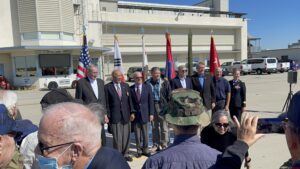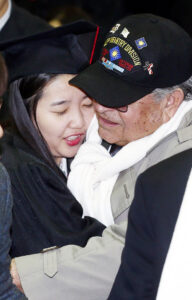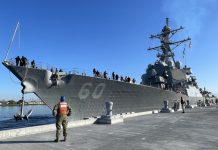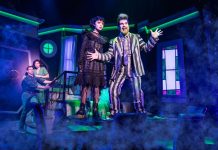
With yet another war raging a world away, local military, government, and civilian leaders gathered recently at Joint Forces Training Base on Feb. 26 to remember the sacrifices, and accomplishments of men and women made in Korea approximately 70 years ago.
While their glory will never fade, many veterans in their 90s gathered on the parade grounds of the base in Los Alamitos last week to celebrate what will likely be their last formal salute.
Top military brass, including Major General Laura L. Yeager, the current commander of the 40th ID, gathered with family members and other officials to “retire the colors” of a contingent of veterans from the U.S. Army’s storied 40th Infantry Division “Sunshine,” for their remarkable service during the Korean War.
The Korean War began on June 25, 1950, when 75,000 soldiers from the North Korean People’s Army crossed the 38th parallel into South Korea. Although Korea was not then strategic to the United States, nearby the USA was already in the throes of a cold war with the Soviets and did not want to appear soft on Communism.
On Saturday, Master of ceremonies Lt. Col. Jonathan Shiroma said the 40th Infantry Division, based in Los Alamitos, deployed from California in late 1951, trained for months in Japan, and moved to the battle in Korea in 1952.
When the 40th reached the front, they fought, and won two of the Korean War’s most infamous battles on “Heartbreak Ridge,” and “Sandbag Castle.” They paid a heavy price with 1457 casualties, including 376 soldiers killed in action and 47 more that later died of injuries, said Shiroma.
Three soldiers in the 40th Infantry Division earned Medals of Honor for their heroism.
Gapyeong is in the center of the Korean Peninsula, and it was the site of one of the fiercest battles of the war. Following the battle of Heartbreak Ridge, the 40th ID pulled back for a break near the town which had been devasted by earlier fighting.
The harsh fighting destroyed the middle school buildings and many of the young students had to study in tent classrooms. The 40th Infantry Division guarded and defended the town as it was strategically located on Seoul’s eastern flank.
Division commander, Maj. Gen. Joseph Cleland, reportedly saw more than 150 South Korean students studying in a tent near artillery fire.

In 1952, he met with the mayor of Gapyeong-gun County, who then asked the U.S. Army’s 40th Infantry Division, the “Sunshine Division,” to build a new school, according to accounts reported by the Korean Ministry of Patriots and Veteran Affairs.
Each of about 15,000 soldiers from the division, led by Brigadier General Joseph Cleland, gathered about $2.50 per person to raise money for a new school. Reports say Cleland put the division’s architects, construction experts, and craftsmen to work designing a plan, then building the school.
Thanks to the funds and some donated infantry equipment, a new school was built in August 1952.
Sgt. First Class Kenneth Kaiser, 19, from Los Angeles was the first man to die in Korea. In his honor, the new school was named. Some battlefield reports indicate Kaiser wanted to teach English to the children.
South Korean school officials originally wanted to call it the Cleland School but the general insisted that they name the school after Kaiser.

The school was called “Gaisa school,” as Gapyeong villagers pronounced the name “Kaiser” as “Gaisa.” It was later changed to the Gapyeong High School and is today a sprawling complex of buildings that spans a city block, including a four-story dormitory, and plans a museum to honor the division soldiers who paid with their blood to save the country and with their pay to save the school.
Estimates say the school has since graduated tens of thousands of students.
Lesser known, according to Korean accounts, the 40th Infantry Division also built another school, the Gwanin Middle School in Gwanin-myeon, Pocheon-si City. Naming the school after its insignia, the sun, the division dubbed the village the “Sunburst Village.”
The gesture has never been forgotten. In the years since, including Saturday, the Korean Ministry of Patriots and Veterans Affairs has sent delegations to the United States while also hosting U.S. military officials from the 40th Infantry in Korea.
The Ministry says it has hosted as many as 15,000 soldiers since the exchange began, inviting them to attend the graduation ceremonies of both Gapyeong and Gwanin schools.
Retiring the Colors

Though a dozen Korean War veterans were able to make it to Saturday’s JFTB ceremony, the soldiers said it was time to “retire the colors.”
Brent Jett, who in the early 1950s was a young Army private serving in the division’s tank company, is the founder and Chairman of the Board of the Korean War Veterans Association. He helped organize the event and traveled to Los Alamitos from Florida to participate.
The bitter cold and savagery of the Iron Triangle are all memories now, yet “today is very important to us. I apologize if I’m a little slow in speaking. We’re all getting into the ’90s.
Half of us are in nursing homes. As a result, many of us are not able to get together for our annual reunions.”
“We have Purple Heart people here today,” he said. “Most of us are Combat Infantry Award Medal winners,” he said. “We’ll always be members of the 40th,” said Jett.
“It’s an honor to follow in your footsteps,” said Gen. Yeager. She also welcomed the sons and daughters of the Korean War veterans, accepting “the responsibilities being handed over to continue the traditions established by the Korean War veterans over many years.”
“It’s hard to believe but it’s 70 years later, and the Korean War remains unresolved and tensions on the peninsula are as deep as ever,” said Yeager.

Courtesy photo
“If not for the divisions like the mighty Sunburst Division,” said Yeager, “the prosperity and peace South Korea enjoy today would not exist. One only needs to look north to North Korea to see what life under cruel communist rule looks like.”
She said “Communist dictators across the globe despise us for our freedoms for our success and happiness as evidence to their people that their way of governing is the wrong way. And if you’re watching the news right now, we’re seeing what’s happening in Ukraine.
And this is just an example of that.”
“The Russian president cannot allow Ukraine to continue to build on their democracy because it highlights how wrong his way of governing is. So it’s up to all freedom-loving people to defend our way of life and stand by our allies and partners,” said Gen. Yeager.
“When asked by our President and our Congress, we in uniform have taken up possibly at the cost of our own lives, to ensure a democratic future for our children and our grandchildren. We owe it to our predecessors, our role models are veterans like you,” she said.
“Today we’re going to retire the colors,” she said, “but you, the veterans of that conflict have been and will continue to be, a part of a long line in the storied history of the 40th Infantry Division.”
Commander J. Kim, head of the Korean Veterans delegation, said “all the Korean people appreciate what the US Army did during the Korean War. We are brothers now so we share our lives together.”
Each year since the end of the Korean War, the Veterans Association traveled to the schools they started to award scholarships to students. While the veterans are too old to continue, their sons and daughters have stepped up to continue the traditions.
Alan Hackler is a part of the Sons and Daughters of 40th Infantry Division Korean War Veterans. He and his family continue to support Korean War veterans.
“Our father was in the 40th Infantry Division and fought in the Korean War and was handling reunions in the past. We did it so much that we want it to continue” he said.
“My sisters and I will continue to take that on because we used to it and our father was a part of it,” said Hackler.











